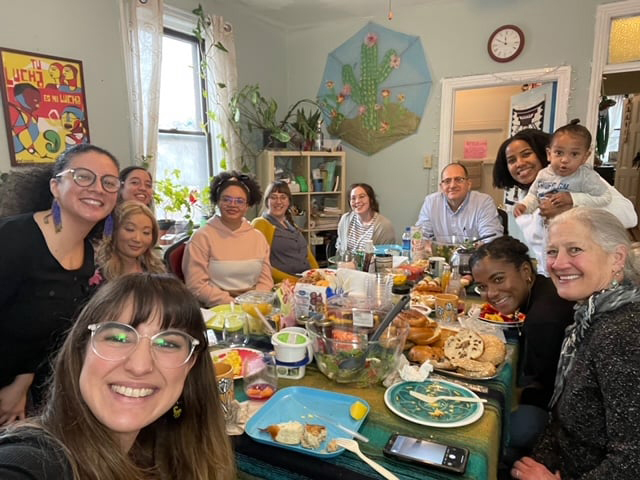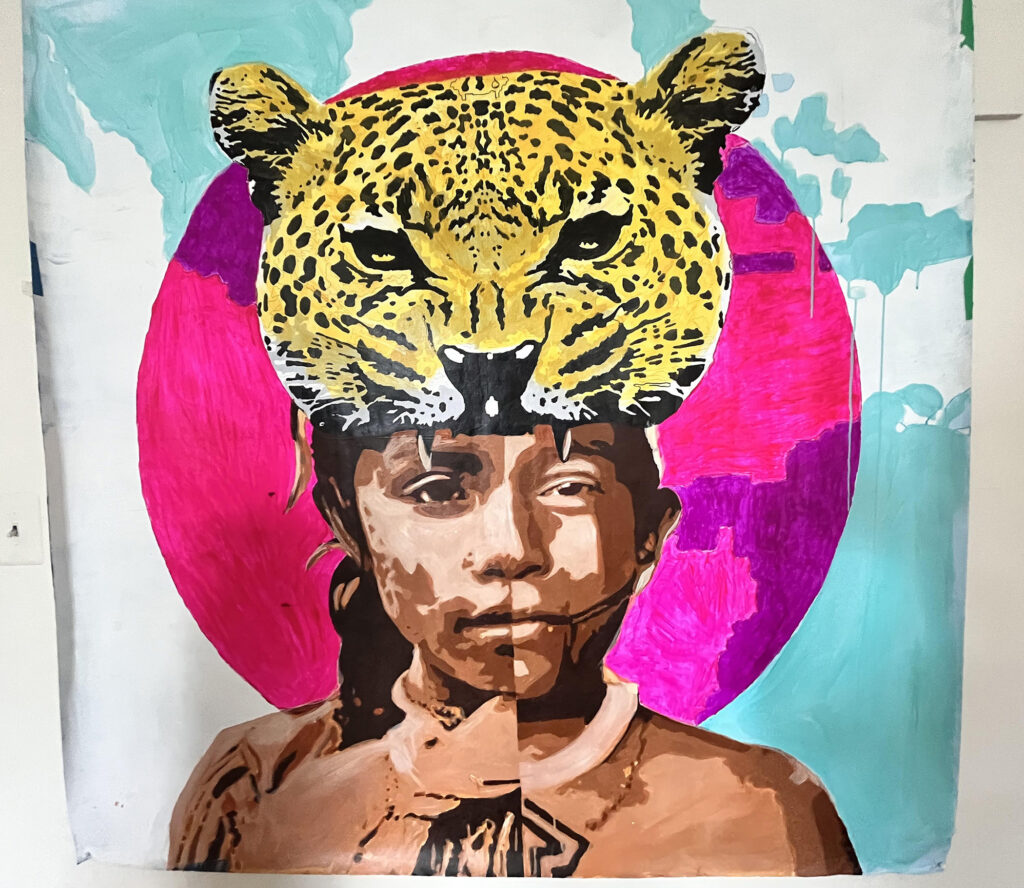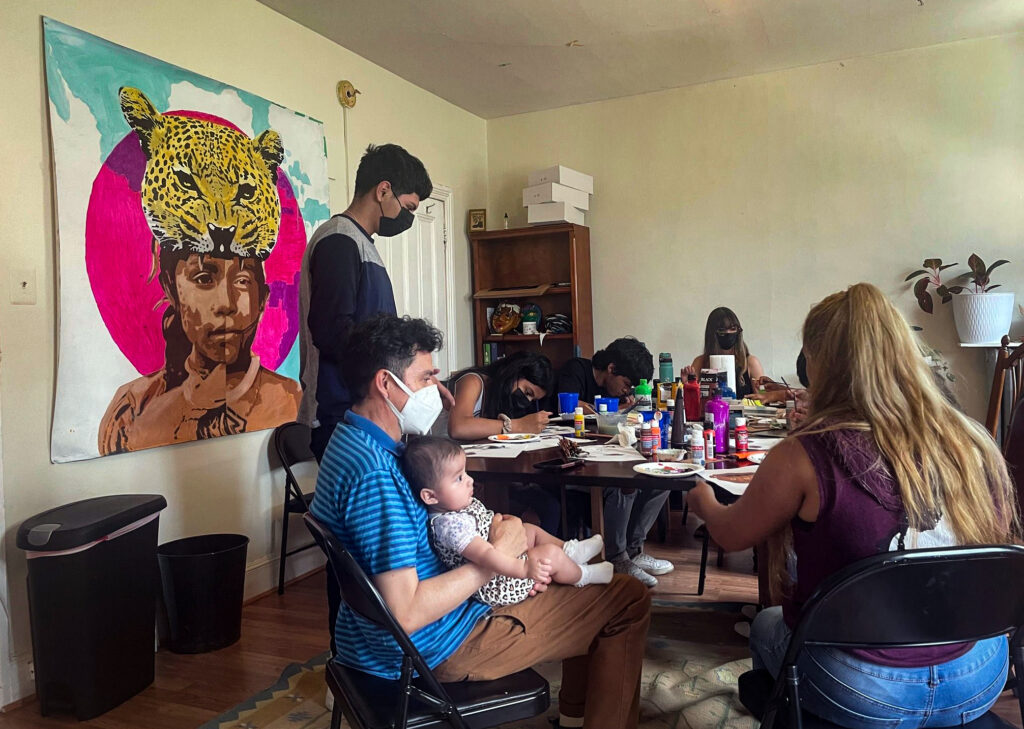Latino organizers expand mental health care to meet community needs

At six years old, Mon Ocampo said goodbye to their mother, who said she was leaving for a business trip with no return date.
“She just knew that she needed to do something for me,” Ocampo said about their then-single mother, who left their home in Honduras in search of better opportunities in the United States.
About five years later, in 2014, Ocampo followed in their mom’s footsteps, traveling to Philadelphia alone. But adapting to life as a teenager in the U.S. wasn’t easy. Ocampo remembers carrying heavy expectations as the family’s firstborn.
“You are the golden ticket out of here,” they said. “You’re supposed to get a degree. You’re supposed to do this and that. So all those expectations were, just, placed on us as soon as we got here.”
In seventh grade, around two years after Ocampo joined their mother in the U.S., they started hurting themselves. A school counselor referred them to La Puerta Abierta —a Philadelphia-based counseling center offering free bilingual therapy to the Latinx immigrant and refugee community.
While mental health is not specific to a single ethnic group, experts say Hispanics have historically been vulnerable to mental health conditions due to barriers to care, exacerbated by COVID-19.
Among adults surveyed in June 2020, more than half of Hispanics reported what experts refer to as at least one adverse mental or behavioral health condition, compared with about 38% of non-Hispanic white adults, according to the U.S. Centers for Disease Control and Prevention.
Hispanic adults reported a higher prevalence of anxiety or depressive disorder, trauma-related and stressor-related disorder, substance use to cope with stress, and suicidal ideation. Researchers said these reflect the “grief, bereavement, and stress related to financial insecurity resulting from the pandemic in Latino communities,” according to the report.
Mark Czeisler, a Harvard University medical student who first authored the 2020 CDC report, said that many structural factors contribute to these trends, including Hispanics being disproportionately represented in the essential worker force and unable to stay at home and quarantine.
“It’s difficult to point to one thing as driving those differences,” he said. “As they stack up, at a certain point, it’s kinda like the straw that breaks the camel’s back.”

The pandemic’s impact on the Latinx community has been profound since its onset, according to Cathi Tillman, La Puerta Abierta’s founding executive director.
“There’s a lot more anxiety,” she said. Tillman has worked through La Puerta Abierta with Latinx immigrant families and individuals in the Philadelphia area since 2005.
The stress from the pandemic on the city’s social structures continued to further marginalize community members already having trouble accessing services like the internet or transportation —affecting kids logging into virtual classrooms or families receiving meals from food distribution systems.
As a result, Tillman saw more clients with anxiety, depression, and physical symptoms like getting headaches or insomnia.
In Philadelphia, over 15 percent of the city’s population is Hispanic, and since 2019, the foreign-born population has represented 14 percent, according to the 2020 U.S. Census and the Pew Charitable Trusts Philadelphia research initiative. Among these populations, Tillman said that many were affected by the changes created by the “new normal.”
“Everything that exists escalated,” Tillman said. “It all trickles down to lack of services and lack of support.”
Tillman said her team had to go to clients’ homes and use personal hotspots on their phones to help them fill out applications to enroll in the school district’s free high-speed internet or to make doctor’s appointments —which they usually don’t do.
The importance of a community model
La Puerta Abierta’s ability to reevaluate the types of requests they respond to, as well as their responsiveness and flexibility, show how vital the role of these types of organizations is to historically underserved communities affected the most by social disparities, experts said.
“Community health workers are attuned to the needs and what works within the context of specific communities in ways that jurisdictions that cover more people are not able to do to the same extent,” Czeisler said. “Ultimately, [they] are the first line of defense or the first line of engagement for a lot of groups, especially people who might usually be outside the safety net of many health care systems.”
In fact, for Czeisler and his co-authors, community-level intervention and prevention models like La Puerta Abierta are part of the answer to addressing mental health trends among the Hispanic or Latinx population.
For over 15 years, this organization has worked towards providing quality and accessible mental health services, like individual or family therapy, to their community. And more recently, they incorporated a program for youth called Compas de Viaje, or travel buddies, which provides extended supportive spaces for those 12 to 20 years old.
Today, La Puerta Abierta sees over 100 clients who, because of barriers due to language, financial, or lack of insurance, believe they’ve been historically excluded from mental health support.
Cultural attitudes and their consequences
For the first time since living in the U.S., Ocampo felt like they could live authentically with their new community at La Puerta Abierta.

It was the first time they could genuinely laugh with friends and open up about what was going on in their lives.
They finally felt heard, they said during a recent interview.
Throughout their teenage years, the La Puerta Abierta community had supported Ocampo and were there when they came out.
“I felt loved,” Ocampo said. “I don’t get to feel that very often, just in the way that I was raised.”
Ocampo remembers that telling their family about going to therapy was difficult initially. Growing up in a family of women, they were told to suck up their feelings, pray to God, move on and be fine.
“If I [told] them that I’m sad, they’re going to look at me and be like, okay, but did you pass your test? Did you pick up your brother? Did you pick up your mom’s medicine? Did you do this that you do that?” they said.
The denial of mental illness and mental health care is not uncommon among the over 62 million individuals within the U.S. Latinx community, La Puerta Abierta team members said.
Tillman said that cultural attitudes and stigmas within the Latinx community often lead to a misconception of what mental health is and requires.
“There’s this attitude that you hand it to God. ‘Primero Dios,’ is what folks will say,” said Tillman. “A lot of times folks will say, ‘when I feel like I’m going to fall apart… I always know that God is always going to take care of things.’”
Tillman said many patients also feel like they’re too weak, the problems are too big, and the trauma is so severe that nothing could help.
As the COVID-19 outbreak in the U.S. evolved, stigmas concerning mental health in some Latinx communities did not help with the community’s worsening mental health needs.
In addition to an increase in reported mental health disorders, the Latinx community also saw more cases of suicidal ideation, reflecting the grief and stress resulting from the pandemic, according to a report from the Preventing Chronic Disease (PCD) journal.
The CDC National Center for Injury Prevention reports that suicides within this population increased nationwide from under 4,000 in 2017 to 4,571 deaths in 2020 — most of those coming from men.
Men having the second-highest suicide mortality rate in the city in 2019 in Philadelphia.
“The stigma around mental health affects people of all genders, but I think there’s maybe some extra pressure on men to be ‘macho,’” said Chesy Tronchoni Bello, a bilingual mental health counselor at La Puerta Abierta, about suicides being much more prevalent in Latinx males.
She said that Latinx individuals socialized as males are expected not to share emotions and open up about problems.
But, of course, the effects of these stigmas vary among families or individuals.
In the youth programs, she noted that the gender breakdown is much more equal, and there is more openness in younger Latinx generations.
“I think that’s a generational thing too,” Tillman said. “There’s more peer support and encouragement.”
More support needed
To increase effective mental health programs that contribute to outcomes like Ocampo’s, Czeisler says that more federal financial investment is essential in supporting state-wide and community efforts to improve mental health care.

“A functional and serviceable mental health care system is going to require investment at multiple levels,” Czeisler said.
Tillman agrees, but also points out that money is not everything.
Training mental health care professionals and those in relevant fields to provide trauma-informed, linguistically appropriate services are also essential. In 2019, the American Psychological Association reported that the psychologist workforce consists of 83 percent white providers. Only 17 percent were identified as racial or ethnic minority providers.
To help overcome this, La Puerta Abierta offers training for bilingual clinicians on properly and effectively responding to the needs of Latinx immigrant youth and their families.
“All of these things are not learned in any clinical programs at school,” Tillman said. “We felt it was our responsibility to provide that level of training.”
For Ocampo, being cared for in a safe environment and watching their peers learn to open up is what led them to stay with the Compas de Viaje program as a senior mentor. Ocampo had been a part pilot cohort during the summer of 8th grade.
They are one of the many mentors, volunteers, graduate student interns, therapists, and counselors at La Puerta Abierta educated in creating trauma-informed spaces for Latinx immigrant youth and families.
“I’m there to make them feel comfortable,” they said. “I’m very open with individual youth, so they come to me to talk and just rant.”
Now, at 20 years old, they are attending community college and have their eyes set on continuing their education at Temple University.
“Have you ever been underwater for a long period of time when you are just dying to grab oxygen?” Ocampo said. “It felt like my chest broke open, and I felt all the air I’ve wanted to get for so many years.”
Tillman sees a national need for equitable and accessible mental health care services for Latinx families and more communities in the U.S. to replicate the La Puerta Abierta organizational model.
Anna Guaracao is a graduate student at Boston University studying journalism. She has a bachelors degree in communication and sociology. She is an intern for CNN’s The Row editorial gatekeeper and fact checking unit. She is pursuing a career in news production. Reach her at aguaraca [at] bu [dot] edu and on Twitter @yosoyannaa.
Thanks for sharing. A very good piece that was informative and eye opening. Being a black man, husband, and father who also has a child in their transition Ocampo has been a valuable source of information and clarity as our family adjusts.